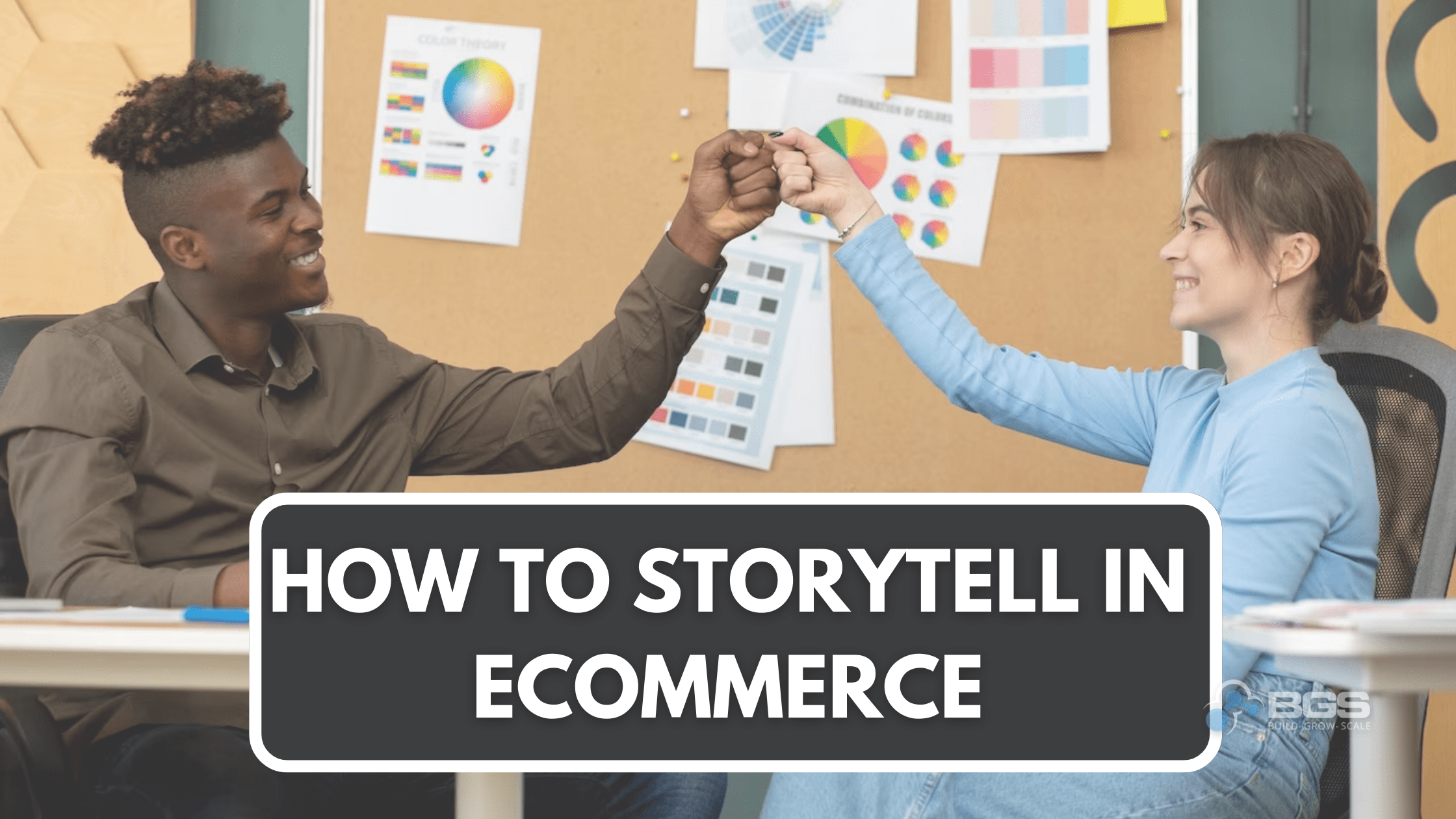A Guide on How to Effectively Craft Your E-commerce Narrative with Storytelling

james backenstose | Aug 13, 2023
Reading Time: 5 minutesYou’re running an ecommerce business, but something’s missing. You’ve got products and a sleek ecommerce store, but where’s the connection? That’s where storytelling comes in. It’s not just for books or movies; how to storytell is a powerful tool that’ll elevate your brand and captivate your customers.
Ready to weave your tale? Let’s dive into the art of effective storytelling for ecommerce and discover tactics that’ll set you apart.
What does Storytelling mean for eCommerce?
You’re probably wondering what storytelling really means for eCommerce, aren’t you? Well, it’s not as complicated as it may seem.
Storytelling in eCommerce is all about crafting a compelling narrative around your brand and products. This is where brand storytelling comes into play.
Think of it like this: every brand has a story, and it’s your job to tell it. You’re not just selling a product; you’re selling an experience, an emotion, a journey. That’s how to storytell effectively. You weave a narrative that wraps your customers in, making them feel connected to your brand on a personal level.
Narrative marketing is an essential tool in your arsenal. It’s about creating an engaging and relatable story that resonates with your audience. This could be a behind-the-scenes look at your company, a heart-touching tale of your product’s creation, or even stories from satisfied customers.
Remember, people don’t just buy products, they buy stories. They buy the why, not just the what. So, don’t just list product features, tell a story.
Unleash the power of brand storytelling to captivate your shoppers and boost your eCommerce business.
Why use Storytelling in eCommerce?
In the world of online retail, you’d be surprised how much a compelling tale can increase your sales. It’s not just about selling products anymore. It’s about selling experiences, dreams, and emotions. Storytelling in eCommerce is a powerful tool that can capture your customers’ attention and influence their purchasing decisions.
You’re not just selling a product, you’re selling a story that your customers can relate to. You’re selling them the idea of a better life, a problem solved, a dream fulfilled. Stories evoke emotions, and emotions drive purchases. It’s that simple. By using storytelling, you can engage your customers on a deeper level and create a strong emotional bond with them.
Moreover, storytelling helps you stand out from the crowd. In an overcrowded online marketplace, a captivating story can differentiate your brand from the competition. It allows you to convey your unique brand identity and values, creating a memorable shopping experience.
So why wouldn’t you use storytelling in eCommerce? It’s a surefire way to boost your sales and build strong customer relationships. Plus, it’s a whole lot of fun.
5 Ecommerce Storytelling Strategies that tell your brand’s story
You’re about to delve into five key strategies that can help you effectively tell your brand’s story in the realm of eCommerce.
You’ll learn how to:
- Craft compelling product descriptions that create a narrative.
- Incorporate customer testimonials for authenticity.
- Utilize visual storytelling to engage your audience.
Furthermore, you’ll discover the importance of:
- Sharing your brand’s mission and values.
- Creating a sense of exclusivity that keeps your customers coming back for more.
Use product descriptions to create a narrative
Crafting a compelling narrative within your product descriptions can really elevate your ecommerce business. You can’t just list features and hope for the best. It’s about connection, about making your customers feel something.
Imagine you’re selling candles. Don’t just say, ‘This is a vanilla-scented, hand-poured soy candle.’ Instead, weave a story. ‘Picture a cozy evening in. You’ve got your favorite book, the rain’s gently tapping at the window, and our hand-poured, vanilla-scented candle is filling the room with a warm, comforting aroma.’
Do you see the difference? You’re selling not just a product, but an experience, a lifestyle. You’re telling a story, and your customer is the protagonist. It’s not about the candle, it’s about the cozy evenings it’ll bring.
Incorporate customer testimonials
Don’t underestimate the power of customer testimonials. They’re an essential part of your product description strategy. When you include real-life experiences from satisfied customers, you’re not just selling a product, but a solution, a feeling, a story. You’re giving potential buyers a glimpse of what it’s like to use your product straight from those who’ve already taken the plunge.
Imagine you’re selling a workout supplement. Instead of just listing its ingredients, you could include a testimonial from a customer who’s seen real fitness improvements. Picture them saying, “This supplement changed my life! I’m hitting personal records I never thought possible!” Now that’s compelling.
Testimonials help build trust, resonate emotionally, and ultimately, encourage sales. So go ahead, let your customers do the talking.
Utilize visual storytelling
Incorporating images and videos in your product descriptions can help bring your products to life, giving potential customers a better understanding of what they’re purchasing. Don’t just rely on words when you can show them exactly what they’re getting. High-quality images and videos can create a more engaging and interactive experience.
You’re not just selling a product, you’re telling a story. A well-placed image or video can illustrate a product’s features, demonstrate its use, or show how it fits into a buyer’s life. It can also add emotional appeal, making your product more relatable and desirable. It’s all about creating a visual narrative that resonates with your audience.
Share your brand’s mission and values
You’ve got to let your customers know about your brand’s mission and values, as this will help build a stronger connection with them and foster brand loyalty. It’s not just about selling products, it’s about sharing a vision, a belief, a goal. They’ll appreciate your transparency and respond positively to your authenticity.
Use storytelling to share what motivates you, why you do what you do, and what you hope to achieve. This shouldn’t be a corporate jargon-filled manifesto but a sincere, easy-to-understand narrative. You’re not just a company, you’re a group of people with a shared purpose.
Create a sense of exclusivity
Creating a sense of exclusivity can really make your customers feel special and valued. You might think about offering limited-edition products or perhaps access to special services only available to a select group. When you weave this exclusivity into your storytelling, it can add a layer of intrigue and desire for your brand.
Let’s say you’re releasing a new product. Instead of just announcing it, why not build anticipation by teasing it as a ‘members-only exclusive’? It’s a simple trick, but it’s one that could really boost your sales and customer loyalty.
Final Thoughts on how to storytell for Ecommerce
So, you’ve learned how to storytell for eCommerce and why it’s beneficial. Remember, storytelling isn’t just about selling products. It’s about connecting with your customers on a deeper level.
With a bit of creativity and authenticity, you can make your brand’s story resonate with your audience and drive your eCommerce success. It’s time to put these strategies into action and watch your brand story unfold!
Frequently Asked Questions
You can measure storytelling’s effectiveness in ecommerce by tracking engagement metrics. Look at traffic, conversion rates, time spent on your site, and social shares. This’ll show if your story’s resonating with customers.
You might face challenges like connecting your story to your product, keeping it relevant to the audience, and maintaining authenticity. If you’re not careful, storytelling can also be time-consuming and potentially off-putting to customers.
Yes, there are various tools you can use. Software like Storyboard That or Adobe Spark helps create engaging visuals. Platforms like Shopify have built-in features for weaving a story into your product descriptions.
Customer feedback greatly shapes your brand’s story. It provides insight into what’s working, what’s not, and how you can improve. Use it to refine your narrative, making it more compelling and relatable to your audience.
Absolutely, storytelling techniques can differ based on the product or service you’re selling. You’d adjust your narrative to fit the product’s features, benefits, and the target audience’s needs and interests.



Table of Contents
What does Storytelling mean for eCommerce?Why use Storytelling in eCommerce?5 Ecommerce Storytelling Strategies that tell your brand’s storyUse product descriptions to create a narrativeIncorporate customer testimonialsUtilize visual storytellingShare your brand’s mission and valuesCreate a sense of exclusivityFinal Thoughts on how to storytell for EcommerceFrequently Asked QuestionsTable of ContentsAbout the authorLeave a Comment Cancel ReplyAbout the author
james backenstose
Introducing the one-of-a-kind, James, more familiarly hailed as the world's unique JimmyApp! Since his embarkation on the journey with Build Grow Scale (BGS) back in November 2017, he's proven to be the company's stalwart, seasoned Revenue Optimization expert—the one with the longest standing tenure. He skillfully helms BGS's largest revenue-generating store, with a dynamic blend of professionalism, acumen, and innovation. • No problem is too complex for James. Whether it's a trivial hiccup or a formidable conundrum, he's your go-to solution virtuoso. His uncanny ability to troubleshoot issues is something to behold, solving them personally 90% of the time. And in those rare instances when the solution eludes his reach, rest assured, he's got a Rolodex of contacts who can step in and get the job done. • But don't let his professionalism deceive you. Behind the knowledgeable facade, there's a jester who never misses an opportunity to infuse the workday with playful antics and quick-witted humor. He has an inherent talent to keep the team motivated while having a laugh, an integral part of his personality that has become a cherished staple at BGS. Alongside this, his day-to-day supportiveness is invaluable, always lending a hand or offering a word of encouragement when needed. • In summary, James, our in-house JimmyApp, is a harmonious blend of wit, fun, professionalism, and remarkable problem-solving prowess. His undeniable presence is felt each day at BGS, making the business world a little less serious and a lot more successful!




